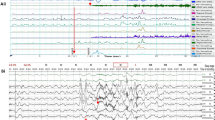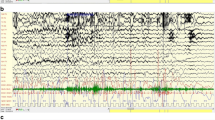Abstract
In this chapter, we will deal with data accumulated about the arousal-driven spontaneous and evoked phasic events. We are looking for characteristics of spontaneous and elicited phasic changes, regularities in their occurrence, and the impact of their existence on the course of sleep. Summarizing the results of earlier works about PAT, K-complexes, and CAP phenomena, a new approach has been used in their systematization. First, we have differentiated arousal-like and sleep-like spontaneous and elicited responses and investigated the relation of these two types with dynamic changes in the course of night sleep. We differentiated these phasic changes from tonic states of sleep and analyzed the interrelationships of the phasic and tonic changes.
Access this chapter
Tax calculation will be finalised at checkout
Purchases are for personal use only
Similar content being viewed by others
References
Ackner B, Pampiglione G. Some relationships between peripheral vasomotor and E.E.G. changes. J Neurol Neurosurg Psychiatry. 1957;20(1):58–64.
Amzica F, Steriade M. The K-complex: its slow (<1-Hz) rhythmicity and relation to delta waves. Neurology. 1997;49(4):952–9.
ASDA (American Sleep Disorders Association). EEG arousals: scoring rules and examples. Sleep. 1992;15:173–84.
Bastien C, Campbell K. The evoked K-complex: all-or-none phenomenon? Sleep. 1992;15(3):236–45.
Bastien C, Campbell K. Effects of rate of tone-pip stimulation on the evoked K-complex. J Sleep Res. 1994;3(2):65–72.
Bastien CH, Crowley KE, Colrain IM. Evoked potential components unique to non-REM sleep: relationship to evoked K-complexes and vertex sharp waves. Int J Psychophysiol. 2002;46(3):257–74.
Bastuji H, García-Larrea L, Franc C, Mauguière F. Brain processing of stimulus deviance during slow-wave and paradoxical sleep: a study of human auditory evoked responses using the oddball paradigm. J Clin Neurophysiol. 1995;12(2):155–67.
Blake H, Gerard RW. Brain potentials during sleep. Am J Physiol. 1937;119:692–703.
Cajochen C, Foy R, Dijk DJ. Frontal predominance of a relative increase in sleep delta and theta EEG activity after sleep loss in humans. Sleep Res Online. 1999;2(3):65–9.
Cash SS, Halgren E, Dehghani N, Rossetti AO, Thesen T, Wang C, et al. The human K-complex represents an isolated cortical down-state. Science. 2009;324(5930):1084–7.
Colrain IM. The K-complex: a 7-decade history. Sleep. 2005;28(2):255–73.
Colrain IM, Webster KE, Hirst G, Campbell KB. The roles of vertex sharp waves and K-complexes in the generation of N300 in auditory and respiratory-related evoked potentials during early stage 2 NREM sleep. Sleep. 2000;23(1):97–106.
Cote KA, de Lugt DR, Langley SD, Campbell KB. Scalp topography of the auditory evoked K-complex in stage 2 and slow wave sleep. J Sleep Res. 1999;8(4):263–72.
Czisch M, Wehrle R, Stiegler A, Peters H, Andrade K, Holsboer F, Sämann PG. Acoustic oddball during NREM sleep: a combined EEG/fMRI study. PLoS One. 2009;4(8):e6749.
Davis H, Davis PA, Loomis AL, Harvey EN, Hobart G. Electrical reactions of the human brain to auditory stimulation during sleep. J Neurophysiol. 1939;2:500–14.
De Gennaro L, Ferrara M, Bertini M. The spontaneous K-complex during stage 2 sleep: is it the ‘forerunner’ of delta waves? Neurosci Lett. 2000;291(1):41–3.
Dijk DJ, Kronauer RE. Commentary: models of sleep regulation: successes and continuing challenges. J Biol Rhythms. 1999;14(6):569–73.
Ehrhart J, Muzet A. Frequency and duration of transitory activation phases during normal or disturbed sleep in man. Arch Sci Physiol (Paris). 1974;28(3):213–60.
Ferri R, Bruni O, Miano S, Terzano MG. Topographic map** of the spectral components of the cyclic alternating pattern (CAP). Sleep Med. 2005a;6(1):29–36.
Ferri R, Rundo F, Bruni O, Terzano MG, Stam CJ. Dynamics of the EEG slow-wave synchronization during sleep. Clin Neurophysiol. 2005b;116(12):2783–95.
Ferri R, Rundo F, Bruni O, Terzano MG, Stam CJ. Regional scalp EEG slow-wave synchronization during sleep cyclic alternating pattern A1 subtypes. Neurosci Lett. 2006a;404(3):352–7.
Ferri R, Bruni O, Miano S, Plazzi G, Spruyt K, Gozal D, et al. The time structure of the cyclic alternating pattern during sleep. Sleep. 2006b;29(5):693–9.
Finelli LA, Borbély AA, Achermann P. Functional topography of the human nonREM sleep electroencephalogram. Eur J Neurosci. 2001;13(12):2282–90.
Fruhstorfer H. Habituation and dishabituation of the human vertex response. Electroencephalogr Clin Neurophysiol. 1971;30(4):306–12.
Gora J, Colrain IM, Trinder J. The investigation of K-complex and vertex sharp wave activity in response to mid-inspiratory occlusions and complete obstructions to breathing during NREM sleep. Sleep. 2001;24(1):81–9.
Halász P. Arousals without awakening – dynamic aspect of sleep. Physiol Behav. 1993;54(4):795–802.
Halász P. K-complex, a reactive EEG graphoelement of NREM sleep: an old chap in a new garment. Sleep Med Rev. 2005;9(5):391–412.
Halász P, Ujszászi J. Spectral features of evoked microarousals. In: Terzano MG, Halász P, Decklerck AC, editors. Phasic events and dynamic organization of sleep. New York: Raven Press; 1991. p. 85–100.
Halász P, Kundra O, Rajna P, Pál I, Vargha M. Micro-arousals during nocturnal sleep. Acta Physiol Acad Sci Hung. 1979;54(1):1–12.
Halász P. The role of the non-specific sensory activation in sleep regulation and in the pathomecha nism of generalized epilepsy with generalized spike-wave discharge. Doctoral thesis, Hungarian Academy of Sciences, Budapest; 1982.
Halász P, Pál I, Rajna P. K-complex formation of the EEG in sleep. A survey and new examinations. Acta Physiol Hung. 1985;65(1):3–35.
Hirshkowitz M. Arousals and anti-arousals. Sleep Med. 2002;3(3):203–4.
Horne JA. Human sleep, sleep loss and behaviour: implications for the prefrontal cortex and psychiatric disorder. Br J Psychiatry. 1993;162:413–9.
Hornyak M, Cejnar M, Elam M, Matousek M, Wallin BG. Sympathetic muscle nerve activity during sleep in man. Brain. 1991;114(Pt 3):1281–95.
Jahnke K, von Wegner F, Morzelewski A, Borisov S, Maischein M, Steinmetz H, et al. To wake or not to wake? The two-sided nature of the human K-complex. Neuroimage. 2012;59(2):1631–8.
Johnson LC, Karpan WE. Autonomic correlates of the spontaneous K-complex. Psychophysiology. 1968;4(4):444–52.
Kohsaka S, Sakai T, Kohsaka M, Fukudac N, Ariga A. Activation of the brainstem precedes and outlasts the K-complex in humans. Neuroscience. 2012;202:243–51.
Loomis AL, Harvey EN, Hobart GA. Distribution of disturbance-patterns in the human electroencephalogram, with special reference to sleep. J Neurophysiol. 1939;2:413–30.
MacFarlane JG, Shahal B, Mously C, Moldofsky H. Periodic K-alpha sleep EEG activity and periodic limb movements during sleep: comparisons of clinical features and sleep parameters. Sleep. 1996;19(3):200–4.
Marzano C, Ferrara M, Curcio G, De Gennaro L. The effects of sleep deprivation in humans: topographical electroencephalogram changes in non-rapid eye movement (NREM) sleep versus REM sleep. J Sleep Res. 2010;19(2):260–8.
Moruzzi G. Active processes in the brain stem during sleep. Harvey Lect. 1963;58:233–97.
Nicholas CL, Trinder J, Colrain IM. Increased production of evoked and spontaneous K-complexes following a night of fragmented sleep. Sleep. 2002;25:882–7.
Niiyama Y, Fushimi M, Sekine A, Hishikawa Y. K-complex evoked in NREM sleep is accompanied by a slow negative potential related to cognitive process. Electroencephalogr Clin Neurophysiol. 1995;95(1):27–33.
Parrino L, Ferri R, Bruni O, Terzano MG. Cyclic alternating pattern (CAP): the marker of sleep instability. Sleep Med Rev. 2012;16:27–45.
Peszka J, Harsh J. Effect of sleep deprivation on NREM sleep ERPs and related activity at sleep onset. Int J Psychophysiol. 2002;46(3):275–86.
Quattrochi JJ, Shapiro J, Verrier RL, Hobson JA. Transient cardiorespiratory events during NREM sleep: a feline model for human microarousals. J Sleep Res. 2000;9:185–91.
Rajna P, Halász P, Kundra O, Pál I. Event-related non-specific responses (K-complexes) during sleep. Acta Med Hung. 1983;40(1):33–40.
Raynal D, et al. K-alpha events in hypersomniacs and normals. Sleep Res. 1974;3:144.
Riedner BA, Hulse BK, Murphy MJ, Ferrarelli F, Tononi G. Temporal dynamics of cortical sources underlying spontaneous and peripherally evoked slow waves. Prog Brain Res. 2011;193:201–18.
Roth M, Shaw J, Green J. The form voltage distribution and physiological significance of the K-complex. Electroencephalogr Clin Neurophysiol. 1956;8(3):385–402.
Sallinen M, Kaartinen J, Lyytinen H. Is the appearance of mismatch negativity during stage 2 sleep related to the elicitation of K-complex? Electroencephalogr Clin Neurophysiol. 1994;91(2):140–8.
Sassin JF, Johnson LC. Body motility during sleep and its relation to the K-complex. Exp Neurol. 1968;22(1):133–44.
Schieber JP, Muzet A, Ferriere PJ. Phases of spontaneous transitory activation during normal sleep in humans. Arch Sci Physiol (Paris). 1971;25(4):443–65.
Sforza E, Jouny C, Ibanez V. Cardiac activation during arousal in humans: further evidence for hierarchy in the arousal response. Clin Neurophysiol. 2000;111(9):1611–9.
Sforza E, Juony C, Ibanez V. Time-dependent variation in cerebral and autonomic activity during periodic leg movements in sleep: implications for arousal mechanisms. Clin Neurophysiol. 2002;113(6):883–91.
Smerieri A, Parrino L, Agosti M, Ferri R, Terzano MG. Cyclic alternating pattern sequences and non-cyclic alternating pattern periods in human sleep. Clin Neurophysiol. 2007;118(10):2305–13.
Takigawa M, Uchida T, Matsumoto K. Correlation between occurrences of spontaneous K-complex and the two physiological rhythms of cardiac and respiratory cycles (author’s transl). No To Shinkei. 1980;32(2):127–33.
Terzano MG, Parrino L. Origin and significance of the cyclic alternating pattern (CAP). Sleep Med Rev. 2000;4(1):101–23.
Terzano MG, Mancia D, Salati MR, Costani G, Decembrino A, Parrino L. The cyclic alternating pattern as a physiologic component of normal NREM sleep. Sleep. 1985;8(2):137–45.
Terzano MG, Halász P, Declerck AC, editors. Phasic events and dynamic organization of sleep. New York: Raven Press; 1991.
Ujszászi J, Halász P. Long latency evoked potential components in human slow wave sleep. Electroencephalogr Clin Neurophysiol. 1988;69(6):516–22.
Wauquier A, Aloe L, Declerck A. K-complexes: are they signs of arousal or sleep protective? J Sleep Res. 1995;4(3):138–43.
Wennberg R. Intracranial cortical localization of the human K-complex. Clin Neurophysiol. 2010;121(8):1176–86.
Author information
Authors and Affiliations
Rights and permissions
Copyright information
© 2013 Springer-Verlag London
About this chapter
Cite this chapter
Halász, P., Bódizs, R. (2013). Recognition of Spontaneous and Evoked Arousal- and Sleep-Like (Antiarousal) Phasic Events. In: Dynamic Structure of NREM Sleep. Springer, London. https://doi.org/10.1007/978-1-4471-4333-8_3
Download citation
DOI: https://doi.org/10.1007/978-1-4471-4333-8_3
Published:
Publisher Name: Springer, London
Print ISBN: 978-1-4471-4332-1
Online ISBN: 978-1-4471-4333-8
eBook Packages: MedicineMedicine (R0)




